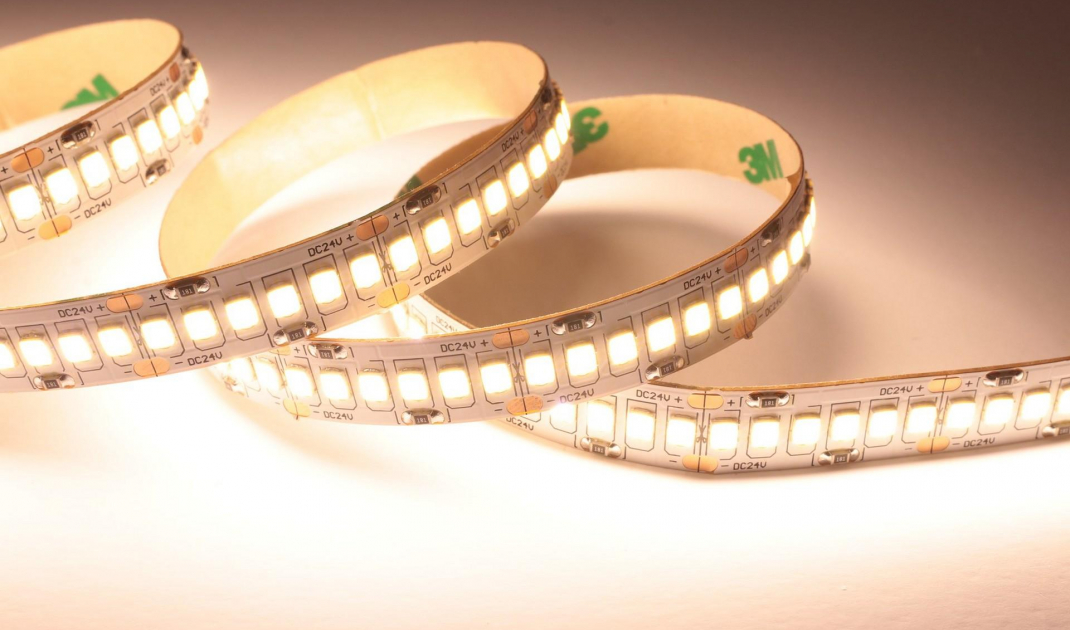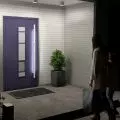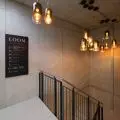This versatile light source can be installed quickly and easily almost anywhere. Not surprisingly, interest in flexible LED strips is growing rapidly in modern lighting design around the world. However, one LED strip is not equal to another, we explain how to read the parameters and what to pay attention to when choosing an LED strip.
Many advantages
LED strips open up a world of creative possibilities. They are extremely versatile and we can install them in almost any place
- They can be supplied as standard or waterproof - for outdoor use or in places where moisture resistance is required.
- Very easy to install, the basic versions are relatively inexpensive and can enliven and change the look of any interior.
- Extremely narrow (just 8 mm wide and 3 mm high) LED strips are ideal for installation in tight spaces where other forms of lighting would be impractical.
- They are energy efficient, consuming very little energy (as little as 4.8 watts per meter), yet still able to produce enough light to replace fluorescent lamps.
- LED strips are available in a wide range of colors. You can choose from white - as well as RGB/RGBW color-changing strips, which, when connected to an LED controller, will allow you to change and mix any shades and colors you want.
Where to use LED strips?
No matter what type you install, LED strips will provide excellent, eye-catching lighting. Here are some examples of typical applications:
-
Pedestal, plinth, paneling and base lighting
-
Doors, windows, floors and stairs
-
Signage and storefronts
-
Bars, clubs and restaurants
-
Functional lighting for cabinets, display cases and countertops
-
Outdoors - gardens, terraces, driveways
-
Christmas tree lights, weddings and other special occasions
-
General work light to replace fluorescent lamps
-
Cabinet lighting - above and below kitchen and bathroom cabinets
-
LED ceiling lights
LED strips have many uses and advantages
© Wikimedia.org
LED strips - basic information
- LED strips can be powered by 12 V or 24 V, through a transformer or fixed-voltage driver. One transformer can power more than one LED strip, as long as their total power is less than the output of the transformer.
- They consist of a flexible base layer - a printed circuit board or PCB - which is covered with adhesive tape and seeded with a row of light-emitting diodes.
- LED strips are usually supplied on spools of different lengths. Each LED tape is marked with special markers - usually at intervals of 25 mm, 50 mm or 100 mm, depending on the type - so you can cut them yourself. Longer lengths can be created by soldering as required.
- White and single-color LED strips can be dimmed using a combination of transformer, receiver and dimmer-switch. Similarly, RGB and RGBW (color-changing) LED strips can be managed with a suitable transformer, receiver and controller.
Parameters technically
The size of the LEDs?
The physical size of LEDs of an LED strip significantly affects its luminous flux (measured in lumens). One size is not better than another - the right choice depends on the purpose of this type of lighting.
- SMD 2835 - an LED with a dimension of 2.8 × 3.5 mm. An improved version of the 3528 LED, with a larger heat sink and higher luminous efficiency. It is lower than its predecessor, so it emits light with a much better angle.
- SMD 3528 - With LEDs measuring 3.5 mm x 2.8 mm, these strips are most suitable for home lighting, where they will be seen up close. Functional lighting in ceiling niches, pedestals, under cabinets, on stair treads and window frames.
- SMD 5050 - With LEDs measuring 5.0 mm x 5.0 mm, these LEDs are 40% larger than SDM 3528. They are about 3x brighter and have 3x more power. Ideal for commercial applications where the observer may be farther away - high ceilings, wall washes, outdoor lighting, ambient lighting in larger areas - or for home applications where more light is required, such as a "work light"
- SMD 5630 - dimensions 5.6 × 3.0 mm. A diode with a smaller surface area than the 5050, but with a rectangular shape. It emits twice as much light as the square SMD 5050 diode and is found mainly in more powerful incandescent bulbs and led strips.
- SMD 5730 - dimensions: 5.7 × 3.0 mm. One of the latest LEDs, which is an improved version of the SMD 5630. The most powerful LED, also emitting the greatest amount of heat, so in their case it is worth using efficient heat sinks. This type of light source is equipped with, among others, LED modules, which from a small number of LEDs, require adequate light brightness.
What colors are available for LED strips?
One of the great advantages of LED tape lighting is the variety of colors and tones available. By choosing the right shade, you can instantly improve the mood and ambience of any room or other place.
- Pure white - white with a cool blue tint. Ideal for kitchens and bathrooms and modern, crisp living. We carry a range of pure whites, from 5000 to 6500k.
- Warm white - a more traditional yellow color, similar to incandescent lighting. Ideal for LED ceiling lighting and home spaces such as bedrooms, living rooms and hallways. We offer warm white from 2700k-3200k
- Single color (red, green, blue or amber) - distinctive shades and colors that will give your rooms a bold effect. Great for commercial spaces such as clubs, bars and restaurants, or for home object lighting.
- RGB-LED strips with a combination of red, green and blue LEDs. By mixing these colors using a controller or smartphone app, you can create any shade you can imagine! (Including pure white).
- RGBW - The next evolution of RGB LED strips. RGBW strips offer a combination of four LED colors - red, green, blue and white. The addition of white light allows us to create pastel shades in addition to all the colors offered by RGB LEDs.
With LEDs, we can create interesting lighting effects in any arrangement
© Wikimedia.org
How many LEDs per meter are on an LED strip?
The brightness of the LED strip depends on the distance between the LED s - that is, the number of LEDs per meter - and the type of SMD (LEDs vary in quality, brightness and reliability: 60 LEDs of higher power can be brighter than 120 LEDs of lower power). LED strips with a higher number of LEDs per meter allow you to create a uniform line of light. The higher the number of LEDs/m, the more intense and uniform the light will be. This also translates, unfortunately, into higher power consumption.
30 LED s per meter - 7.5 Watt (RGB) LED strips.
60 LEDs per meter - 5 W / 15 W (white), 15 W (single color) and 15 W (RGB) LED strips.
120 LEDs per meter - 15 watt / 20 w double power / 25 watt (white) LED strips.
240 LEDs per meter - 20 watt standard power (white) LED strips.
LED strips - IP degrees
IP, or Ingress Protection, is the industry standard for how waterproof an LED strip is and how resistant it is to dust.
- IP33 - Standard LED strip, without waterproofing. For indoor use in dry, dust-free areas such as bedrooms and living rooms, ceiling trims, showcases and walls .
- IP65 - Coated LED strip. This strip has a shrink coating. (It outperforms some alternative resin coatings and will not discolor over time or crumble in cold temperatures.)
- IP67 - Waterproof LED strip. These strips are protected with shrink film (similar to our IP65 strips), with the addition of fully taped ends. Although they are waterproof, they should not be installed in areas under water (e.g. not in a pond). Indoors, IP67 strips are a good choice for bathrooms or kitchens, near showers, sinks and other splash-prone areas. Outdoor applications include paths, driveways and walls.
Operating temperature
LED strips typically operate at temperatures from -25C to +60C.
What kind of power supply for LED lights?
To calculate the wattage of the power supply that the transformer will need to output, multiply the number of meters of LED strip you want to power by the wattage of the strip per meter. (For example, 5 meters of 20-watt LED strip will require a transformer of 5 × 20 watts = 100 watts).
If you are installing the installation outdoors or in areas prone to splashing, you must choose a waterproof transformer (IP67).
Development: Dominika Tyrlik
Content source: zarowka-led.com


























